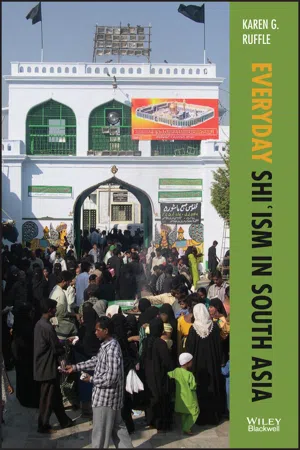
- English
- ePUB (mobile friendly)
- Available on iOS & Android
Everyday Shi'ism in South Asia
About this book
The first textbook to focus on the history of lived Shi'ism in South Asia
Everyday Shi'ism in South Asia is an introduction to the everyday life and cultural memory of Shi'i women and men, focusing on the religious worlds of both individuals and communities at particular historical moments and places in the Indian subcontinent. Author Karen Ruffle draws upon an array primary sources, images, and ethnographic data to present topical case studies offering broad snapshots Shi'i life as well as microscopic analyses of ritual practices, material objects, architectural and artistic forms, and more.
Focusing exclusively on South Asian Shi'ism, an area mostly ignored by contemporary scholars who focus on the Arab lands of Iran and Iraq, the author shifts readers' analytical focus from the center of Islam to its periphery. Ruffle provides new perspectives on the diverse ways that the Shi'a intersect with not only South Asian religious culture and history, but also the wider Islamic humanistic tradition. Written for an academic audience, yet accessible to general readers, this unique resource:
- Explores Shi'i religious practice and the relationship between religious normativity and everyday religious life and material culture
- Contextualizes Muharram rituals, public performances, festivals, vow-making, and material objects and practices of South Asian Shi'a
- Draws from author's studies and fieldwork throughout India and Pakistan, featuring numerous color photographs
- Places Shi'i religious symbols, cultural values, and social systems in historical context
- Includes an extended survey of scholarship on South Asian Shi'ism from the seventeenth century to the present
Everyday Shi'ism in South Asia is an important resource for scholars and students in disciplines including Islamic studies, South Asian studies, religious studies, anthropology, art history, material culture studies, history, and gender studies, and for English-speaking members of South Asian Shi'i communities.
Frequently asked questions
- Essential is ideal for learners and professionals who enjoy exploring a wide range of subjects. Access the Essential Library with 800,000+ trusted titles and best-sellers across business, personal growth, and the humanities. Includes unlimited reading time and Standard Read Aloud voice.
- Complete: Perfect for advanced learners and researchers needing full, unrestricted access. Unlock 1.4M+ books across hundreds of subjects, including academic and specialized titles. The Complete Plan also includes advanced features like Premium Read Aloud and Research Assistant.
Please note we cannot support devices running on iOS 13 and Android 7 or earlier. Learn more about using the app.
Information
1
South Asian “Lovers” of the Ahl‐e Bait: Hindu and Non‐Shiʿi Muslim Traditions of Devotion
Muharram beyond Shiʿism: The “Composite Culture” of Commemorating Karbala in South Asia
The Husaini Brahmins: Hindu Devotees of Imam Husain
| Wah Dutt Sultan, | Oh, King Dutt |
| Hindu ka Dharm | A follower of the Hindu religion |
| Musalman ka Iman, | And the Muslim faith, |
| Adha Hindu, Adha Musalman. | Half Hindu, half Muslim. |
Table of contents
- Cover
- Table of Contents
- Title Page
- Copyright Page
- Dedication Page
- Acknowledgments
- Transliteration Note
- Introduction
- 1 South Asian “Lovers” of the Ahl‐e Bait
- 2 “Come, and Cry, Because ʿAshura Is Today”
- 3 In the House of the Tenth
- 4 Metal Hands and Stone Footprints
- 5 Every Place Is Karbala, Every Day Is ʿAshura
- 6 Tasting Sorrow before Joy
- Afterword
- Teaching Appendix
- Glossary
- Index
- End User License Agreement